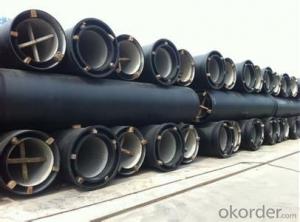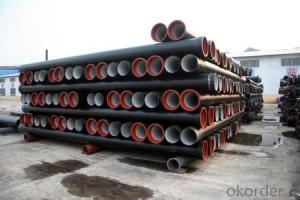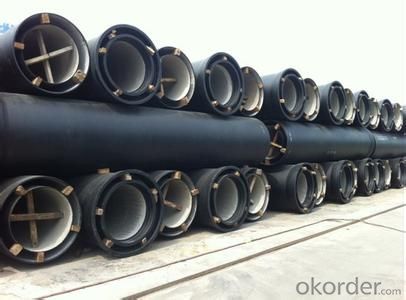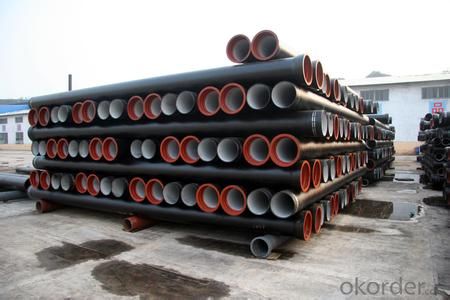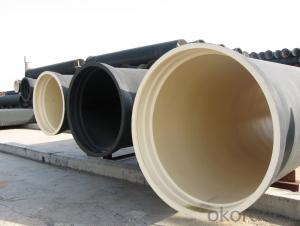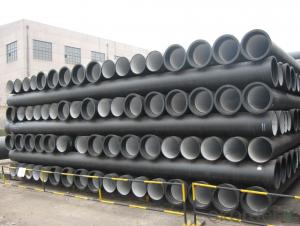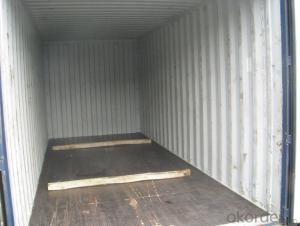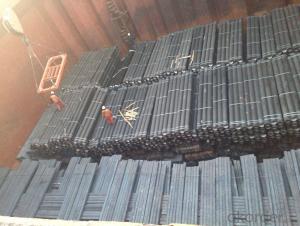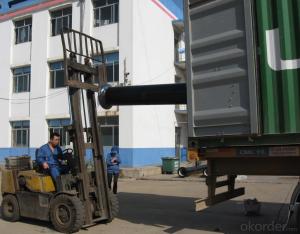DUCTILE IRON PIPES K8 DN1000
- Loading Port:
- China Main Port
- Payment Terms:
- TT OR LC
- Min Order Qty:
- -
- Supply Capability:
- -
OKorder Service Pledge
OKorder Financial Service
You Might Also Like
Ductile Iron Cast Pipe is without any defects compare with tradition casting tech, which has many advantages particularly as follow:
(1) High density. In the "vertical upward casting" process, the melt iron of centre liquid column in center crystallizer is continuously feeding for volume shrinkage caused by condensation tube at outer circumference , which lead to be free of shrinkage porosity.
(2) High purity. When melt iron pouring, the mixed impurities such as gas, dross, sand grain which are lighter than melt iron could be eliminated at furnace mouth, its impossible to enter into the crystallizer through the channel, so the melt iron into the crystallizer is very pure.
(3) Strength with toughness. The cooling speed provided by continuous crystallizer is 30 times than sand casting and 5 times than centrifugal casting, and doesn't produce white iron, the eutectic cell volume of continuous cast iron is one eighth to one tenth compare with traditional cast iron. The density of graphite nodule in ductile iron can reach 300-700 pcs/mm2. Therefore, all reason above improve the strength and toughness of continuous cast iron.
(4) Free machining. The high speed cooling make the hardening phase (such as boride, steadite) not appear like reticular, massive or thick, but diffuse like fish bone and pane in shape, moreover, there are tiny graphite flakes inlaid hardening phase. It's free machining in BrinellHardness the range of 250-300HB. However, the Brinell Hardness of 250 is top limit to common metal materials.
(5) Uniform composition of tube wall. The convection mixing of liquid column caused by marching type drawing in crystallizer make the composition of tube wall well-distributed, and concentration gradient very little.
(6) High productivity. To the wall thickness of tube under 10mm, the speed of continuous casting is 1 meter/min, to the wall thickness of tube under 20mm, the speed of continuous casting is 0.5 meter/min, which is high efficiency that centrifugal or other casting tech couldn't reach.
- Q: How do ductile iron pipes handle extreme temperatures?
- Ductile iron pipes, known also as cast iron pipes, possess the ability to effectively handle extreme temperatures. The material composition of ductile iron enables it to endure both high and low temperatures without experiencing significant damage or degradation. When exposed to high temperatures, ductile iron pipes demonstrate exceptional thermal resistance, rendering them suitable for applications involving the transportation of hot liquids or gases. The high melting point of ductile iron, ranging from 2060°C to 2200°C, guarantees that the pipes can withstand extreme heat without melting or distorting. Consequently, these pipes are ideal for utilization in industries such as oil and gas, steam distribution, and high-temperature water supply systems. Likewise, ductile iron pipes exhibit satisfactory performance in low-temperature environments. They possess a low coefficient of thermal expansion, thereby enabling them to endure the expansion and contraction that occurs during temperature fluctuations without cracking or fracturing. This quality makes them appropriate for use in cold climates or in applications involving the transportation of chilled liquids or gases. Furthermore, ductile iron pipes possess excellent thermal conductivity, allowing them to efficiently dissipate heat. This characteristic proves particularly significant in high-temperature applications where effective heat transfer is vital to prevent damage to the pipes or the materials being transported. In conclusion, ductile iron pipes effectively handle extreme temperatures due to their high melting point, low coefficient of thermal expansion, and exceptional thermal conductivity. These attributes establish them as a dependable choice for various applications involving extreme temperature conditions.
- Q: Can ductile iron pipe be used for water treatment plant sludge handling?
- Indeed, water treatment plant sludge handling can utilize ductile iron pipe. Renowned for its robustness and longevity, ductile iron pipe is well-suited for managing diverse fluid types, such as sludge. It possesses the ability to endure the corrosive characteristics of sludge and remains resistant to abrasion, a crucial aspect in any sludge handling system. Moreover, the smooth interior surface of ductile iron pipe aids in preventing obstructions and facilitates the smooth flow of sludge, resulting in enhanced efficiency. In conclusion, ductile iron pipe is an dependable option for water treatment plant sludge handling.
- Q: How are ductile iron pipes protected against internal corrosion caused by chemicals?
- Ductile iron pipes are protected against internal corrosion caused by chemicals through the application of protective linings or coatings. These linings, such as cement mortar, polyethylene, or epoxy, create a barrier between the pipe and the corrosive chemicals, preventing direct contact and corrosion. Additionally, corrosion inhibitors can be added to the water or fluid being transported to further minimize the risk of internal corrosion. Regular inspection and maintenance also play a crucial role in identifying potential corrosion issues and taking appropriate preventive measures.
- Q: What is the disadvantage of nodular cast iron in excess of silicon?
- Therefore, the increase of silicon content in nodular iron greatly improves the strength index and reduces toughness. Ductile iron has a greater crystalline undercooling and a tendency to chill when treated by spheroidizing, and silicon reduces this tendency.
- Q: How are ductile iron pipes protected against root intrusion?
- Ductile iron pipes are protected against root intrusion through various methods and techniques. One commonly used approach is the application of root inhibitors or growth regulators. These chemicals are typically injected into the soil around the pipes, creating a barrier that inhibits root growth near the pipe. This helps prevent roots from penetrating the pipe and causing damage. Another method involves the use of physical barriers such as root barriers or sleeves. These are installed around the pipes to physically block the roots from accessing them. Root barriers are typically made of materials like plastic or metal and are designed to withstand the pressure exerted by growing roots. Additionally, regular maintenance practices such as periodic inspections and cleaning are essential in preventing root intrusion. By monitoring the condition of the pipes and removing any existing root masses, the risk of further root intrusion can be minimized. It is worth noting that preventative measures are more effective than reactive measures when it comes to protecting ductile iron pipes against root intrusion. Therefore, implementing proactive strategies during the installation phase, such as proper pipe bedding and alignment, can help reduce the likelihood of root intrusion in the first place. Overall, a combination of chemical treatments, physical barriers, and appropriate maintenance practices can significantly enhance the protection of ductile iron pipes against root intrusion, ensuring their long-term durability and functionality.
- Q: How does ductile iron pipe compare to steel pipe in terms of durability?
- Ductile iron pipe is generally considered to be more durable than steel pipe. It has superior strength and durability due to its unique microstructure, which allows it to withstand higher levels of pressure, impacts, and loads. Ductile iron pipe also has better corrosion resistance properties, making it less prone to rust and deterioration compared to steel pipe. Additionally, ductile iron pipe has a longer lifespan and requires less maintenance, making it a more reliable and durable choice for various applications.
- Q: What kind of joints are used with ductile iron pipe?
- Mechanical joints or push-on joints are commonly utilized with ductile iron pipe. Mechanical joints involve a gland and a rubber gasket for connecting pipes. These joints are fastened using bolts or other mechanical methods to ensure a secure and tight connection. On the contrary, push-on joints do not demand bolts or extra hardware. They only require the insertion of a rubber gasket into the socket of the pipe, resulting in a sealed connection. Both types of joints are extensively employed with ductile iron pipe, providing dependable and leak-proof connections for diverse applications.
- Q: Can ductile iron pipes be used in areas with high levels of heavy metal contamination?
- Yes, ductile iron pipes can be used in areas with high levels of heavy metal contamination. Ductile iron pipes have a high resistance to corrosion, which makes them suitable for transporting water in such environments. Additionally, their durable nature helps prevent the release of heavy metals into the water supply, ensuring the safety and integrity of the system.
- Q: Can ductile iron pipes be used for firefighting systems?
- Yes, ductile iron pipes can be used for firefighting systems. Ductile iron pipes are known for their strength, durability, and ability to withstand high pressure. They are commonly used in various applications, including firefighting systems, due to their resistance to corrosion and their ability to handle the flow of water efficiently.
- Q: Can ductile iron pipes be used for marine applications?
- Yes, ductile iron pipes can be used for marine applications. Ductile iron has excellent corrosion resistance properties, making it suitable for use in marine environments where exposure to saltwater and other corrosive elements is common. Additionally, its high strength and durability make it a reliable choice for various marine applications such as seawater intake and discharge systems, offshore platforms, and marine pipelines.
Send your message to us
DUCTILE IRON PIPES K8 DN1000
- Loading Port:
- China Main Port
- Payment Terms:
- TT OR LC
- Min Order Qty:
- -
- Supply Capability:
- -
OKorder Service Pledge
OKorder Financial Service
Similar products
Hot products
Hot Searches
Related keywords

